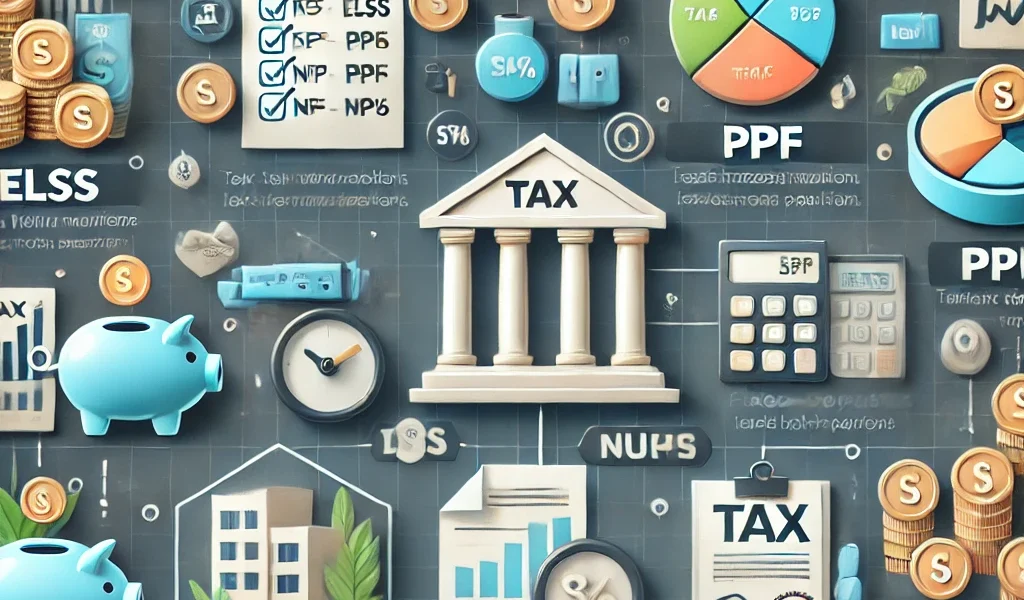Introduction
Paying taxes is an essential responsibility, but smart tax planning can help you reduce your tax liability while growing your wealth. By investing in the right tax-saving instruments, you can take advantage of deductions under various tax laws and maximize your savings. In this guide, we’ll explore the best tax-saving investment plans that help you save more and earn more.
Why Should You Invest in Tax-Saving Plans?
- Reduce Taxable Income – Certain investments offer deductions under tax laws, lowering your taxable income.
- Wealth Creation – Many tax-saving options double as investment vehicles, helping you grow wealth.
- Financial Security – These investments often provide stability for long-term financial goals.
- Retirement Planning – Some options help build a retirement corpus with tax benefits.
- Encourages Discipline – Tax-saving plans often come with lock-in periods, ensuring consistent savings.
Best Tax-Saving Investment Options
1. Equity-Linked Savings Scheme (ELSS)
- Tax Benefit: Deduction under Section 80C (Up to ₹1.5 lakh per year).
- Returns: 12-15% (Market-linked).
- Lock-in Period: 3 years.
- Why Choose ELSS? High return potential with the shortest lock-in period among 80C investments.
2. Public Provident Fund (PPF)
- Tax Benefit: Exempt-Exempt-Exempt (EEE) status under Section 80C.
- Returns: ~7-8% (Government-backed, risk-free).
- Lock-in Period: 15 years (Partial withdrawals allowed after 6 years).
- Why Choose PPF? Ideal for long-term, risk-free savings with tax-free returns.
3. National Pension System (NPS)
- Tax Benefit: Deduction under Section 80CCD(1), 80CCD(2), and 80CCD(1B).
- Returns: 9-12% (Market-linked).
- Lock-in Period: Till retirement (Partial withdrawals allowed after 3 years).
- Why Choose NPS? Best for retirement planning with additional tax savings on ₹50,000 under 80CCD(1B).
4. Fixed Deposits (Tax-Saving FD)
- Tax Benefit: Deduction under Section 80C.
- Returns: 5.5-7.5% (Fixed return).
- Lock-in Period: 5 years.
- Why Choose FD? Secure, predictable returns with tax-saving benefits.
5. Unit Linked Insurance Plans (ULIPs)
- Tax Benefit: Deduction under Section 80C, maturity proceeds tax-free under Section 10(10D).
- Returns: Varies based on market performance.
- Lock-in Period: 5 years.
- Why Choose ULIP? Combines insurance with investment benefits.
6. Senior Citizens Savings Scheme (SCSS)
- Tax Benefit: Deduction under Section 80C.
- Returns: ~7-8.5% (Government-backed).
- Lock-in Period: 5 years (Extendable by 3 years).
- Why Choose SCSS? Best for retirees looking for secure returns.
7. Sukanya Samriddhi Yojana (SSY)
- Tax Benefit: Deduction under Section 80C.
- Returns: ~7-8% (Government-backed, risk-free).
- Lock-in Period: Until the girl turns 21 (Partial withdrawal at 18 years).
- Why Choose SSY? Best for securing a girl child’s future with tax-free returns.
8. Employee Provident Fund (EPF) & Voluntary Provident Fund (VPF)
- Tax Benefit: Deduction under Section 80C.
- Returns: ~8.5% (Government-backed, tax-free interest).
- Lock-in Period: Till retirement (Partial withdrawals allowed in certain cases).
- Why Choose EPF/VPF? Ideal for salaried employees seeking long-term, tax-free savings.
How to Choose the Right Tax-Saving Investment?
Consider these factors before selecting an investment plan:
- Your Financial Goals – Are you saving for retirement, wealth creation, or security?
- Risk Appetite – Do you prefer risk-free investments (PPF, FD) or higher returns with market exposure (ELSS, NPS)?
- Lock-in Period – Can you keep your money invested for a long duration?
- Tax Exemption on Returns – Some investments offer tax-free maturity benefits.
- Liquidity Needs – Will you need access to funds before maturity?
Common Mistakes to Avoid in Tax Planning
- Waiting Until the Last Minute – Plan investments at the start of the financial year.
- Investing Without Research – Choose investments that align with your financial goals.
- Over-Investing in One Option – Diversify your investments to balance risk and returns.
- Ignoring Lock-in Periods – Ensure you can commit to the required duration.
- Not Factoring in Inflation – Opt for investments with inflation-beating returns.
Conclusion
Tax-saving investments are a crucial part of financial planning. By choosing the right mix of investment options, you can maximize tax benefits while ensuring long-term financial security. Whether you prefer market-linked investments like ELSS and NPS or risk-free options like PPF and FDs, a well-planned tax-saving strategy will help you save more and earn more. Start investing today and make the most of your tax-saving opportunities!




